The Google Nexus 5X Review
by Brandon Chester on November 9, 2015 8:00 AM EST- Posted in
- Smartphones
- LG
- Mobile
- Android 6.0
- Nexus 5X
Display
A smartphone's display is unquestionably one of its most important aspects, and failing to deliver a good display can be a fatal flaw for a device. If the screen doesn't have sufficiently high brightness and contrast then its usability with high ambient lighting will be severely crippled. Inaccurate color rendition will cause photos and videos that are taken and viewed on the device to look radically different from other devices. Pushing a wide color gamut can also have ramifications that go beyond making the display inaccurate, such as reducing battery life on AMOLED devices by having to drive a higher voltage in order to achieve the wider gamut.
Last year's Nexus 6 ended up being a significant disappointment as far as the display was concerned. It was immediately obvious to me that the gamut was far too large, and that peak brightness was too low. My testing confirmed both of these things, and I was disappointed mainly because the Nexus 5 from the previous year sold for significantly less than the Nexus 6, and sported imperfect but relatively good display calibration. While this year's Nexus 6P is an AMOLED display that we are yet to test, the Nexus 5X sports an IPS LCD like its predecessor. At 5.2", this year the display is a bit bigger than the 4.95" Nexus 5, but it's still a far cry from the 5.96" display that was on the Nexus 6.
To analyze the quality of the Nexus 5's display I've run it through our standard display testing suite. As always, displays are calibrated to 200nits of brightness, and results are measured with an i1Pro 2 spectrophotometer, and managed using SpectraCal's CalMAN 5 software. Contrast measurements are done with an i1Display Pro colorimeter due to the i1Pro 2's more limited accuracy with very low brightness levels.
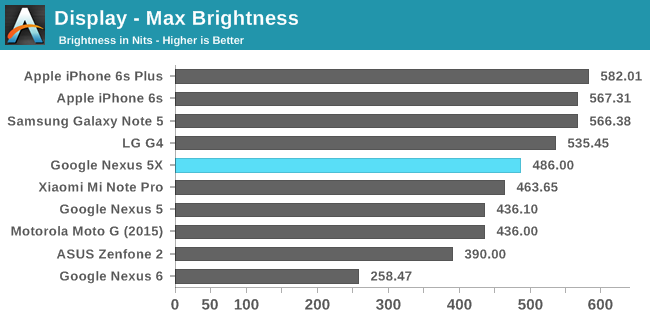

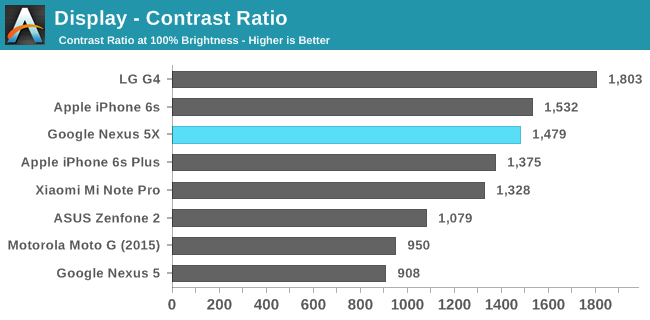
The most basic data point to examine when moving beyond resolution is a display's maximum brightness and its contrast ratio. The Nexus 5X does very well here, with a peak brightness of 486 nits, and a minimum black level of 0.32 nits, which leads to a contrast ratio of 1479:1. This is the result of the use of photo-alignment to influence subpixel orientations and reduce light leakage, which results in deeper blacks and thus a higher contrast ratio. While many other LCD-based smartphones are also using this technology, to see it applied to a $379 smartphone is very exciting. The display's maximum brightness is also a healthy improvement over the Nexus 5, and I haven't run into any situations where the display can't get bright enough to counter glare from the cover glass.
Something that doesn't really show up in any of our figures is the visibility of the display's capacitive sensors. On the Nexus 5 these were fairly noticeable when there was any light shining on the display, and this is unchanged on the Nexus 5X. This is something that can be observed on every device with capacitive touch, although on AMOLED devices and iPhones it's extremely hard to see. I only felt it was worth pointing out because it does seem more pronounced on the Nexus 5X than some of the other devices I have.
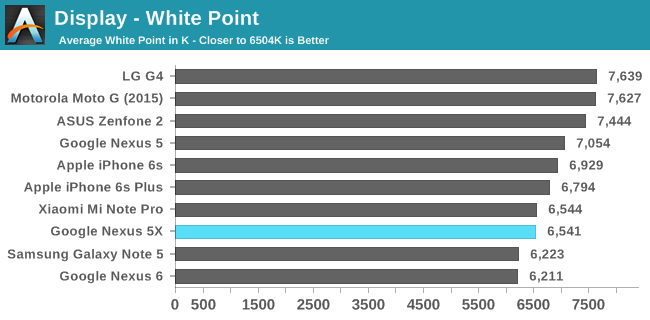
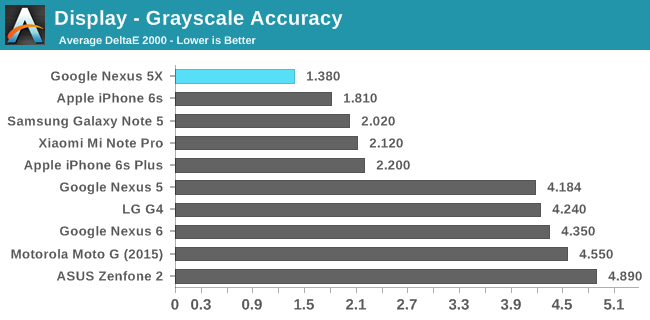
Greyscale accuracy on the Nexus 5 is impeccable. Gamma does tend slightly upward as one moves past the 20% mark, but it's still quite accurate and most greyscale errors are approaching the point where the human eye could not even distinguish them from their reference colors when placed side by side. The RGB component balance for each shade of grey is also very good, and the display's average white point is only ever so slightly above the targeted 6504K. There's not much more to say, as this level of calibration is exceptional for a device of this price. The Nexus 5 certainly had fairly good calibration, but issues with the gamma made the display appear washed out which was a common complaint, and the Nexus 5X resolves that while also boosting accuracy significantly.
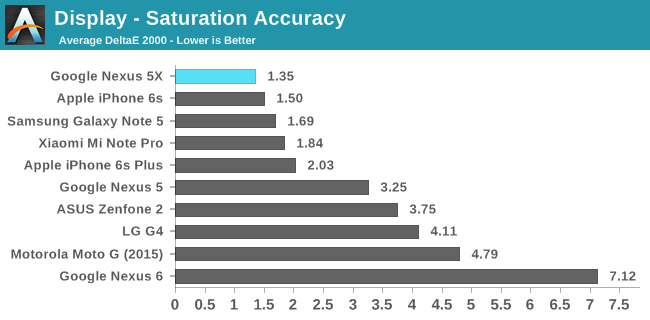
The accuracy for 20% saturation steps on the Nexus 5X is also incredibly high. It's actually the lowest DeltaE on record for a smartphone - lower than even the Galaxy Note5 and iPhone 6s - and there's honestly nothing at all that I could criticize about the rendition of primary and secondary colors on the display. The chart above also shows how much improvement has been made compared to the Nexus 5 and Nexus 6, with the latter being especially bad due to its overly wide gamut.
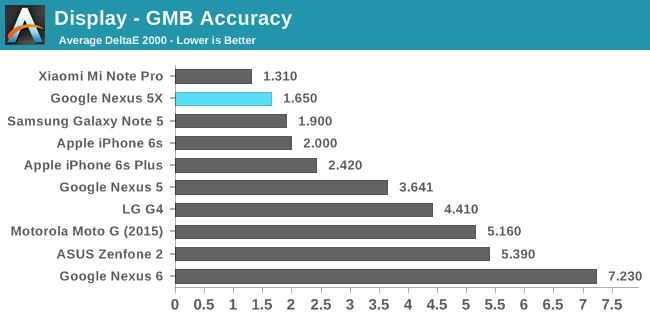
Once again the Nexus 5X provides an incredibly high level of accuracy, with color mixtures being reproduced almost as accurately as primary and secondary colors. It's not the absolute best result on record due to the Mi Note Pro's even higher level of accuracy, but you would only be able to tell that the rendition is wrong if you had the color right beside the reference color with absolutely no motion occurring, and that's well beyond the level of accuracy that is really necessary for a mobile device.
I really don't know what else to say about the Nexus 5X's display, because there's really nothing that can be criticized. I would certainly like if the brightness went up to 600 nits, but I would also prefer that it went to 6000 nits, and obviously that's asking a bit much. As far as LCDs go, the Nexus 5X has one of the best, if not the best that I've seen to date. At this point Google and their OEM partners are going to have to look to gamut as a vector of improvement, but only after proper color management is available at the OS level in order to avoid the problems that have plagued wider gamut displays, which have lacked suitable color management to properly map sRGB content into the wider color space.


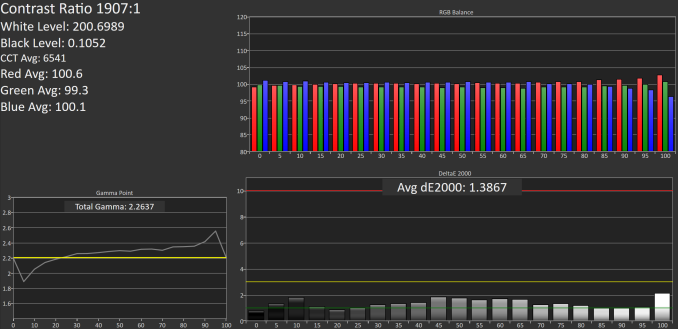
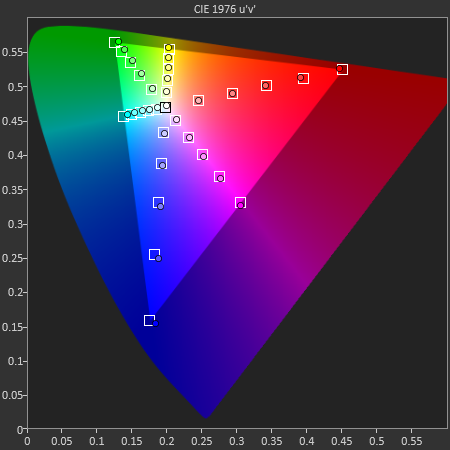









197 Comments
View All Comments
Brandon Chester - Tuesday, November 10, 2015 - link
We use iPerf 2 as well, with similar settings but a 60 second test period and only a single thread. 5X is on the latest firmware from Google, and the router is an Archer C7. The phones are always tested right beside the router.I actually tested the Nexus 6 and Galaxy S6 in the exact same configuration to make sure there wasn't some bug, and they achieved the same speeds that we've recorded previously.
Kumar Anand - Tuesday, November 10, 2015 - link
Brandon - Thanks for your reply. This explains the difference. Here is my explanation.With single iperf stream, the CPU utilization is not enough for Nexus 5X and hence due to aggressive power save on Nexus 5X, the CPU clock frequency is likely scaling down impacting the overall Wi-Fi end to end throughput. Hence it is not really the Wi-Fi but the CPU power save that is preventing us from realizing the full capacity of Wi-Fi. Think of this as the classic performance vs power trade off. Nexus 5X has very good battery life due to aggressive power save policy. Other devices might not have as aggressive CPU scaling policy as Nexus 5x and hence do not impact the Wi-Fi TPUT even with the single iperf stream.
If the intention is to see how much (maximum) TPUT Nexus 5X Wi-Fi can handle or achieve, we should pump enough traffic to take the CPU scaling behavior out of the equation. If you run with -P3 iperf option and pump 3 iperf traffic streams, you can realize the full capacity of Wi-Fi throughput. I am able to achieve more than ~600 Mbps consistently with -P3 option.
In summary - the following statement "Nexus 5X's WiFi performance is not very high for a dual spatial stream 802.11ac implementation" is not accurate. A dual spatial stream 11ac chip (like the one in Nexus 5x) can definitely achieve more than ~600 Mbps but you just need to pump enough traffic. I would be very curious to see your revised comparative numbers with -P3 option.
Thank you.
Kumar Anand - Tuesday, November 17, 2015 - link
Hi Brandon - Did you run comparative tests with iperf -P3 option? Are you considering including the revised numbers with -P3 option? For achieving peak performance we should pump 3 streams of iperf traffic. This will really test what is the "max" throughput each of the phones can handle.FL777 - Tuesday, November 10, 2015 - link
Great review. Your phone reviews are the best on the internet with the one exception of your iPhone 6S review where you fall in love with the Apple SoC so much that you start gushing. Yeah the iPhone 6S is the fastest phone on the planet, but it lacks a lot of the sophisticated and very useful features that the Samsung 6S Edge and the Samsung Note 5 have.Google has really stepped up with teh 5x. The 6p is supposed to be a super phone also. I can't wait to see what the Galaxy S7 will look like. It's SoC is supposed to be a beast and the camera is supposed to be the first smartphone camera that rivals dedicated cameras.
Hanknah - Tuesday, November 10, 2015 - link
Do you know of any reason why the Nexus 5x seems to be currently priced at USD $450-550? amazon.com has it from 450-510 and the google store has it from 500-550. I live in Canada so the google store might be showing me Canadian prices but amazon.com is showing the numbers in USD I'm pretty sureRyan Smith - Tuesday, November 10, 2015 - link
The 5X is being sold directly by Google in the US. So Amazon prices would be reseller prices I expect.Goodspike - Tuesday, November 10, 2015 - link
What would be nice is to have test comparisons of new mid-range devices to high end devices from 3-4 years ago. I tried to go back and look at some earlier reviews, but many of the tests have changed (even ones with the same names). But my point is by doing so people would know if they could save money by foregoing something faster than what they have now.evolucion8 - Tuesday, November 10, 2015 - link
I had the Nexus 5 and I wasn't that fond of it, It felt cheaper and less premium compared to the Nexus 4, the camera was horrible when taking pictures and videos, the battery life was disappointing and the SOC would throttle a lot! I returned it and got its brother, the LG G2 and its so much better on every discipline, much better battery life, better screen, much better camera and better build quality. My only grief is that its list of custom ROMs is much smaller compared with what you can get for the Nexus 5, :-(jay401 - Tuesday, November 10, 2015 - link
Does this phone have WiFi Calling?Brandon Chester - Tuesday, November 10, 2015 - link
I actually don't know. Here in Canada we're basically in the dark ages so no carriers have it.